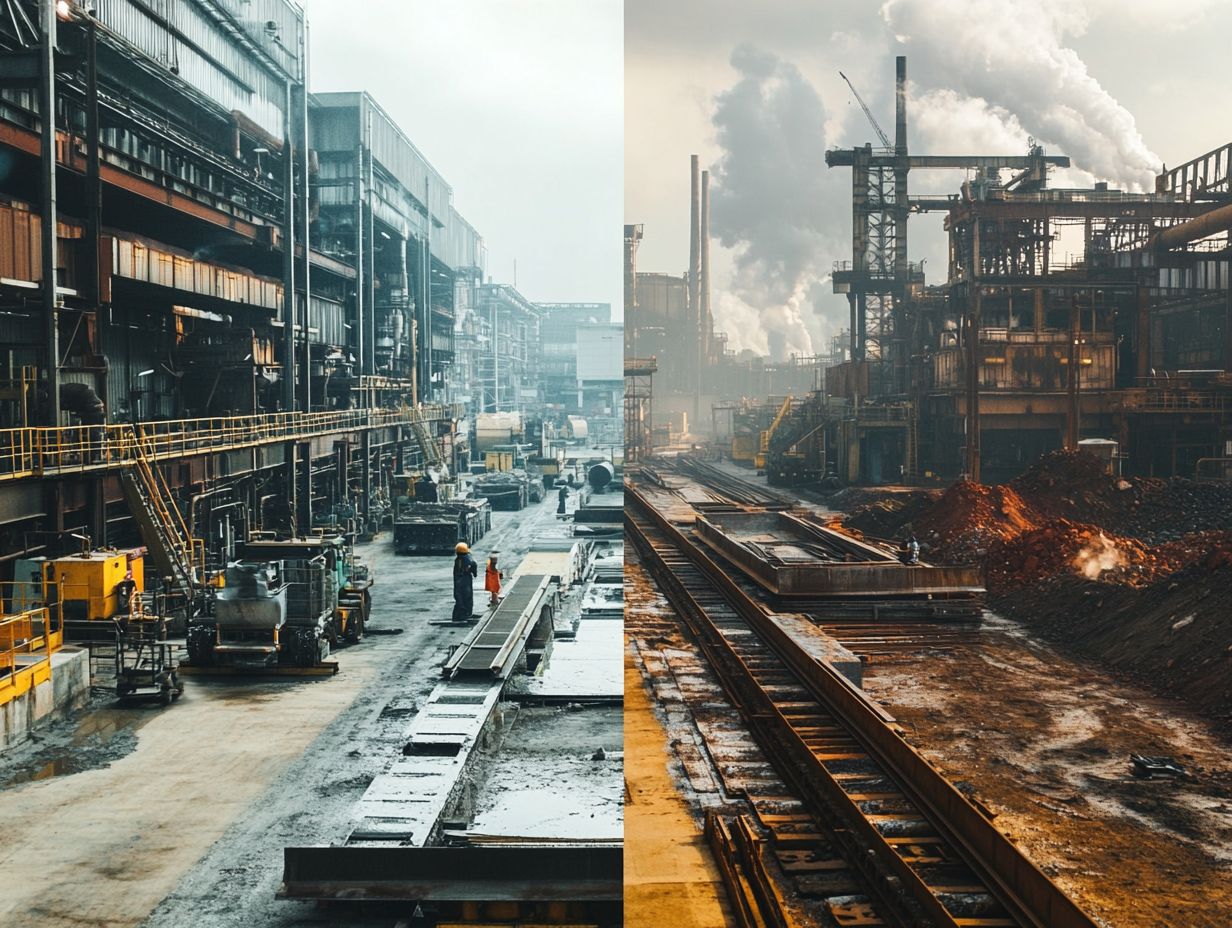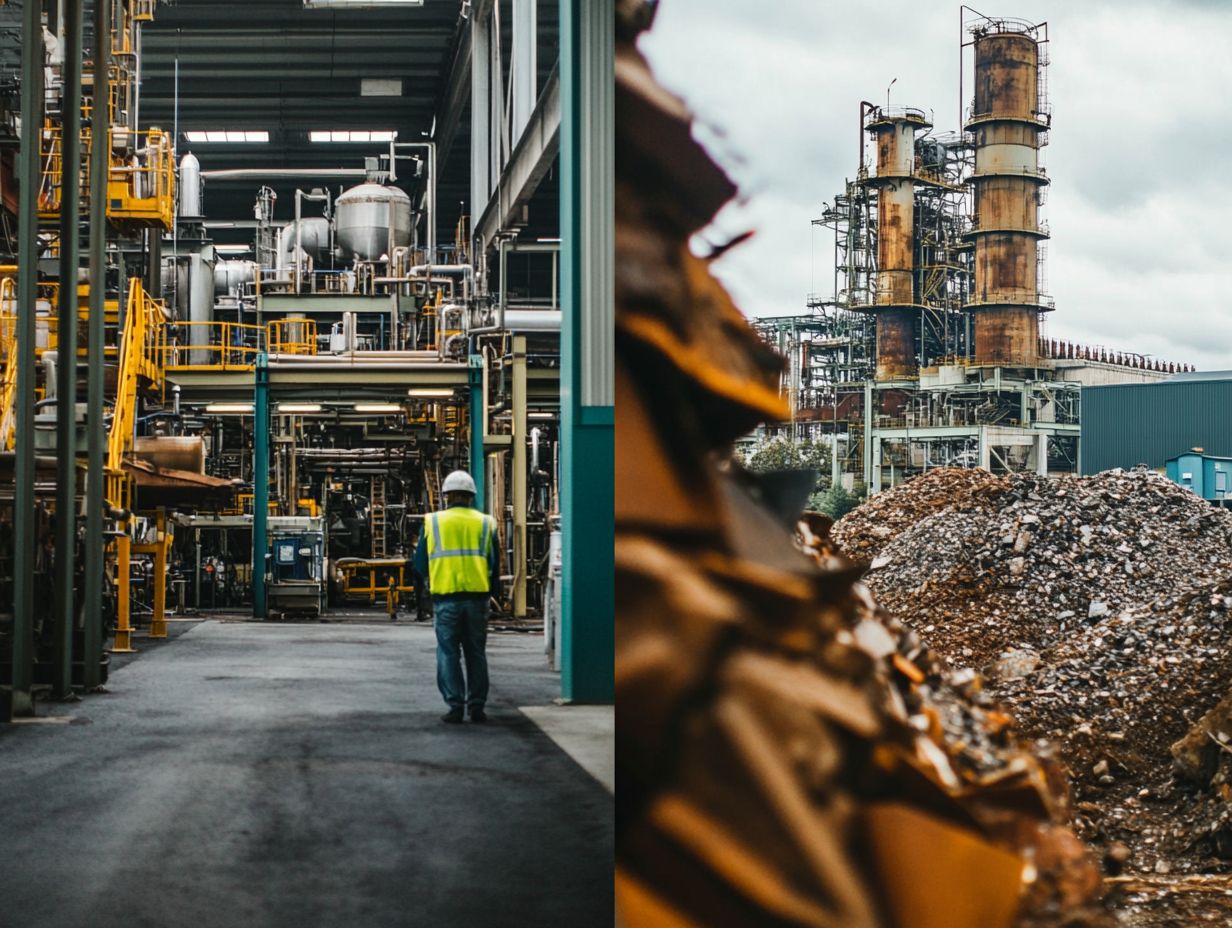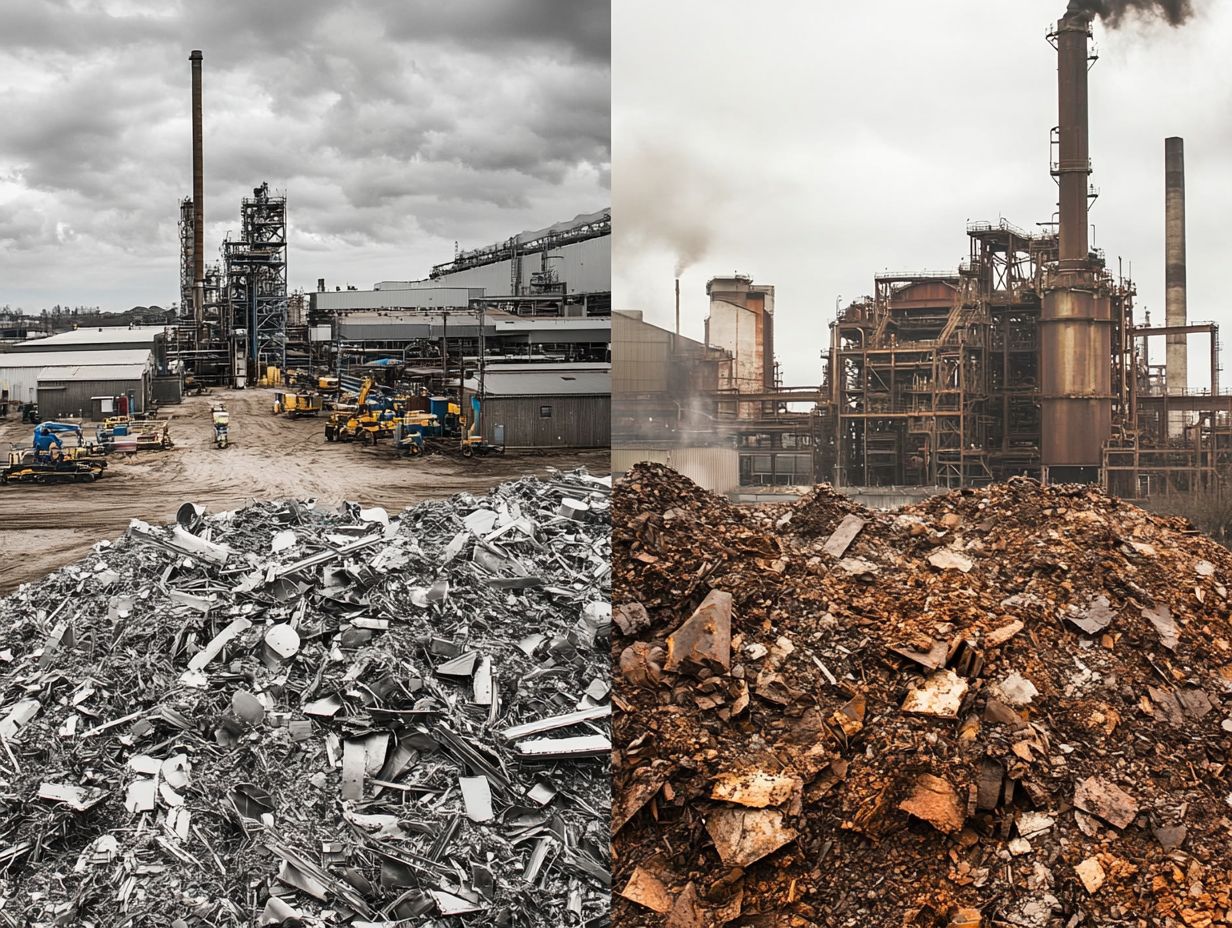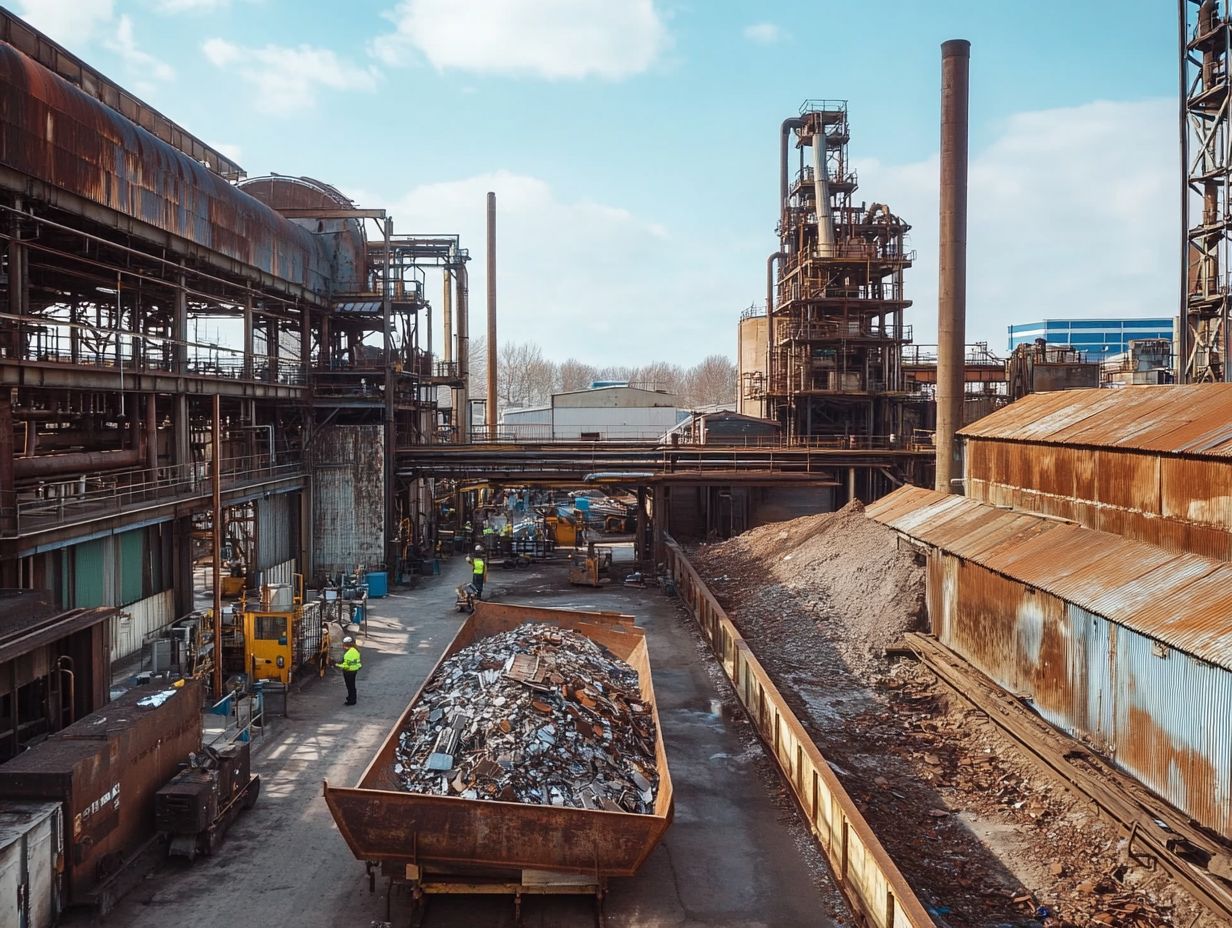The Pros and Cons of Recycled Steel
Recycled steel is steadily emerging as a sustainable option in construction and manufacturing. It’s crucial to carefully assess its advantages alongside any potential drawbacks.
This article delves into the environmental benefits, cost-effectiveness, and efficiency of recycled steel while confronting concerns related to health, safety, and overall quality.
Before deciding to opt for recycled steel, consider key factors and compare it with other materials available on the market. By making informed decisions, you can pave the way for smarter, more eco-friendly choices.
Contents
- Key Takeaways:
- Advantages of Recycled Steel
- Disadvantages of Recycled Steel
- Considerations Before Choosing Recycled Steel
- Alternatives to Recycled Steel
- Frequently Asked Questions
- What is recycled steel and why is it important to consider its pros and cons?
- What are the environmental benefits of using recycled steel?
- What are the economic benefits of using recycled steel?
- What are the drawbacks of using recycled steel?
- How does the use of recycled steel impact the steel industry?
- Is using recycled steel the best option for sustainability?
Key Takeaways:

Recycled steel offers environmental benefits by reducing greenhouse gas emissions and minimizing waste in landfills. Choosing recycled steel can lead to cost savings and efficiency for businesses through reduced energy and resource consumption. Potential health and safety concerns and limitations in quality and durability should be carefully evaluated before selecting recycled steel as a material.
What is Recycled Steel?
Recycled steel is steel reclaimed from scrap metal and repurposed for new applications, significantly reducing the need for virgin materials like iron ore and coal. This recycling process preserves the steel’s strength and durability, making it perfect for various construction and manufacturing applications.
By adopting this eco-friendly approach, you can minimize waste, decrease pollution, and contribute to a more sustainable supply chain all while reducing reliance on energy-intensive production methods.
You can source steel from various places, including old buildings, automobiles, and industrial machinery. Different types of recycled steel cater to specific needs within the construction and manufacturing sectors.
The importance of recycling steel cannot be overstated; it can save up to 75% of the energy required to produce new steel, positioning it as a true game changer for the industry.
Entities like GLE Scrap Metal highlight this impact, as their operations play a crucial role in the extensive collection and processing of scrap steel. In fact, statistics show that nearly 70 million tons of steel are recycled annually in the U.S. alone.
This highlights the incredible environmental benefits while strengthening the economy by creating jobs and reducing production costs, making recycled steel an invaluable resource in today’s world.
Advantages of Recycled Steel
The advantages of recycled steel are abundant, offering a range of benefits that extend from environmental impact to considerable cost savings and enhanced efficiency in manufacturing processes.
This makes it an exceptionally appealing option for sustainable construction. By opting for recycled materials, you help the steel industry reduce the consumption of natural resources, lower CO2 emissions, and decrease energy requirements.
This choice also boosts economic growth.
Environmental Benefits
Recycled steel presents remarkable environmental advantages, notably in reducing pollution and greenhouse gas emissions critical factors in the fight against climate change. By diverting steel from landfills and reintegrating it into the manufacturing process, you contribute to a decrease in the industry’s overall environmental footprint, championing eco-friendly practices.
The American Institute of Steel Construction highlights that utilizing recycled steel can save up to 74% of the energy needed to produce new steel from raw materials. This not only conserves precious natural resources but also significantly curtails air and water pollution, nurturing healthier ecosystems.
With nearly 70 million tons of steel recycled each year in the United States, the impact is substantial. Just one ton of recycled steel can prevent the emission of approximately 1.5 tons of carbon dioxide, underscoring the vital role recycled steel plays in climate action initiatives.
By choosing recycled steel, you empower industries to act now for a sustainable future!
Cost Savings and Efficiency

Using recycled steel can significantly cut costs. It also boosts efficiency in manufacturing, giving your business a strong economic edge.
Research from the World Steel Association shows that recycling steel can cost up to 75% less than acquiring new raw materials, particularly with fluctuations in iron ore prices. This distinction lowers your raw material costs and enhances operational efficiencies since recycled materials typically require less energy to produce.
By embracing recycled steel, you can position your company advantageously within eco-conscious markets. This helps attract consumers focused on sustainability. Investing in recycling initiatives may also give you an edge in market share, aligning your commitment to sustainability with evolving customer preferences.
Disadvantages of Recycled Steel
While recycled steel has many advantages, we must weigh these factors carefully to make the best choice! It’s essential to acknowledge potential drawbacks, such as health concerns and limitations in quality and durability.
Although recycled steel retains beneficial properties, variations in its material composition can result in inconsistent performance, especially in demanding applications.
Potential Health and Safety Concerns
There are health and safety concerns associated with using recycled steel, particularly regarding environmental hazards and pollution from the recycling process. If not properly managed during production, contaminants in scrap metal can pose health risks for workers and the surrounding community.
To address these issues, strict regulations are in place, emphasizing safety measures in the industry. Organizations like the Occupational Safety and Health Administration (OSHA) and the Environmental Protection Agency (EPA) enforce guidelines to ensure safe handling and processing of recycled materials.
Facilities are often required to implement comprehensive training programs for workers, focusing on best practices for managing hazardous substances.
By adhering to these standards, the industry can significantly reduce the risk of exposure to harmful agents, fostering a safer working environment and minimizing negative impacts on public health.
Limitations in Quality and Durability
While recycled steel presents numerous advantages, it’s important to recognize its limitations in quality and durability, especially in structural applications where strength is critical.
Variations in the composition of recycled materials can lead to inconsistencies that may compromise the integrity of the final product. These differences, stemming from various sources of scrap, can result in lower tensile strength, which is the resistance of a material to breaking under tension, compared to virgin steel or stainless steel.
Engineers may face challenges when trying to integrate recycled options into frameworks requiring high load-bearing capabilities or exposure to harsh environments.
Although recycled steel is often more cost-effective, the trade-offs in long-term performance and maintenance require thoughtful consideration.
In some cases, alternative materials like aluminum or high-strength composites may provide a more dependable solution, especially for projects that prioritize durability and longevity.
Considerations Before Choosing Recycled Steel

Before opting for recycled steel in construction or manufacturing projects, it s essential to evaluate several key considerations.
Think about the trade-offs concerning cost, quality, and environmental impact. Your choice should be informed by specific supply chain details and the particular application, ensuring optimal performance and sustainability.
Evaluating the Trade-offs
Evaluating the trade-offs associated with using recycled steel is crucial for making informed decisions in construction and manufacturing. You must weigh the benefits of cost savings and environmental impact against potential limitations in performance and quality.
This analysis includes financial considerations, sustainability, and compliance with regulations that influence project outcomes.
For instance, consider a high-profile project in California that successfully utilized recycled steel. This project reduced costs by 20% while also significantly minimizing carbon emissions. However, it faced challenges in sourcing quality materials that met structural standards, illustrating the delicate balance between eco-friendliness and performance durability.
Such case studies underscore the importance of thorough research and assessments for stakeholders. It’s vital to ensure that your choices do not compromise safety or longevity while championing greener practices.
Alternatives to Recycled Steel
When evaluating materials for construction and manufacturing, explore alternatives to recycled steel, such as stainless steel and recyclable metal from iron. Each option presents unique advantages and disadvantages.
By understanding these alternatives, you can make informed decisions that align perfectly with your project goals and requirements. Explore your options now to stay ahead in eco-friendly construction!
Comparing Different Materials
Comparing different materials like recycled steel, stainless steel, and recyclable metal from iron is crucial for grasping their unique properties and determining their suitability for various applications. Each material has its own set of advantages and limitations that can significantly influence your project outcomes.
Take recycled steel, for example. Its strength often matches or even surpasses that of virgin steel, making it a dependable choice for construction projects. On the cost front, using recycled steel is typically more economical, helping to lower material expenses and reduce energy consumption during processing.
From an environmental perspective, recycled steel offers a lower carbon footprint than both stainless steel and recyclable metal from iron, aligning well with sustainability goals you might have for your project. Case studies from various industries showcase its effectiveness in building frameworks and automotive components, highlighting its versatility.
Experts frequently advocate for recycled steel due to its resilience and long-term benefits. This further establishes its reputation as an increasingly preferred material in modern engineering.
Frequently Asked Questions
What is recycled steel and why is it important to consider its pros and cons?
Recycled steel is steel that has been processed and reused from scrap metal instead of using raw materials. It is important to consider its pros and cons because it significantly impacts the environment, economy, and industries that rely on steel production.
What are the environmental benefits of using recycled steel?
Recycling steel reduces the need for mining raw materials, which can cause deforestation and habitat destruction. It also saves energy and reduces greenhouse gas emissions, making it a more sustainable option for steel production.
What are the economic benefits of using recycled steel?
Recycled steel can be more cost-effective than using raw materials, as it requires less energy and resources to process. It also reduces the need for waste disposal and can create jobs in the recycling industry.
What are the drawbacks of using recycled steel?
One drawback is that the quality of recycled steel may not be as high as that of new steel, as it may contain impurities that can affect its strength and durability. Recycling steel also requires specialized equipment and processes, which can be costly.
How does the use of recycled steel impact the steel industry?
The use of recycled steel can reduce the demand for new steel, which can affect the profits of steel manufacturers. However, it also presents new opportunities for companies to invest in recycling and offer more environmentally friendly products.
Is using recycled steel the best option for sustainability?
Using recycled steel offers many environmental benefits. However, it may not always be the best choice for sustainability.
We must consider factors like the transportation of scrap metal. Also, think about the energy and resources needed for recycling.
It’s crucial to look at the entire life cycle of steel production. This helps us find the most sustainable option.







